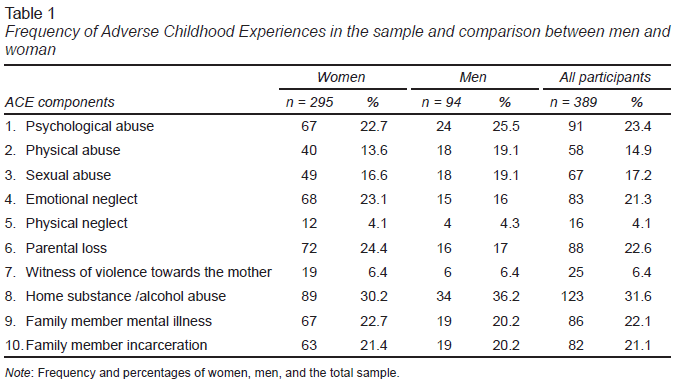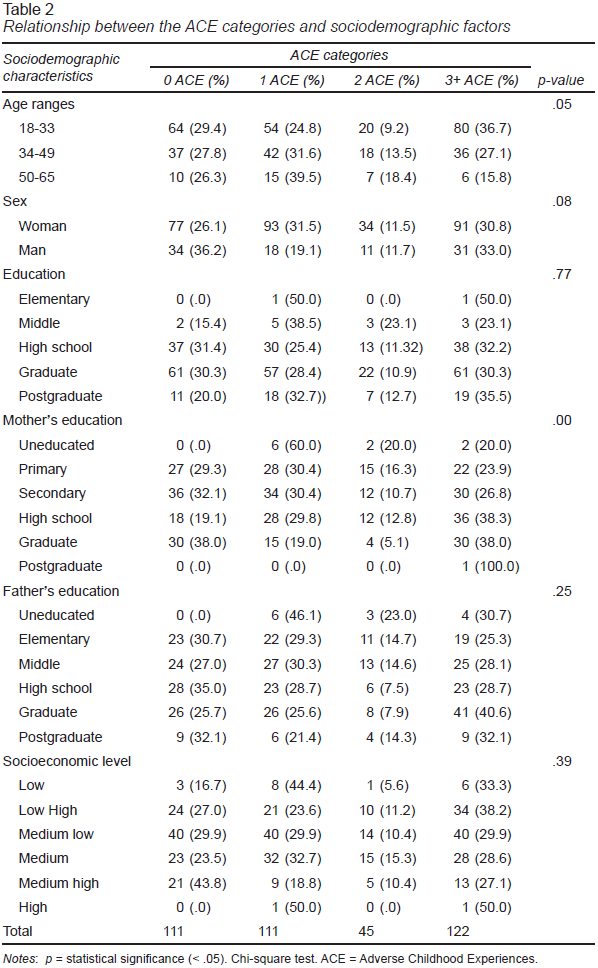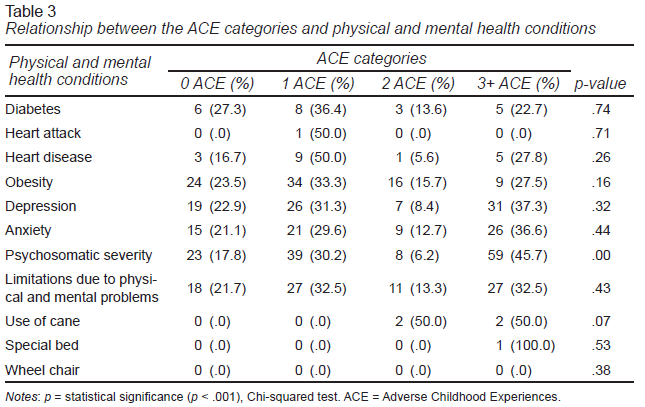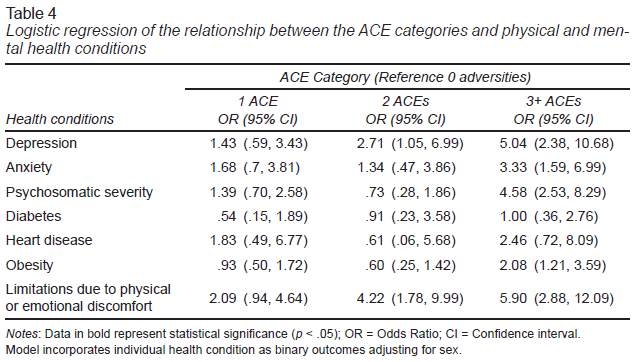Introduction
The term adverse childhood experiences (ACEs) is used to refer to a set of potentially harmful events suffered during childhood that may lead to long-term consequences on physical and mental health (Kalmakis & Chandler, 2014). Such experiences include abuse (physical, psychological, sexual, and neglect) and family dysfunction, such as alcoholism, drug addiction, witnessing violence, divorce, mental illness, or imprisonment of a family member (Felitti et al., 1998).
Early life adversity has been associated with suffering and lack of control over the events, causing permanent stress and an important impact on crucial stages of an individual’s physical and mental development (Shonkoff, 2016). Prolonged stress and a poor quality of life during childhood can cause metabolic, immune system, hormonal, and neurological changes in adulthood (Chiang, Taylor, & Bower, 2015; Danese & McEwen, 2012; Vig, Paluszek, & Asmundson, 2020). This causes adverse events to have consequences later in life (Bryan, 2019; Hughes et al., 2017; McLaughlin, Weissman, & Bitrán, 2019; Norman et al., 2012; Shonkoff, 2016) and a permanent effect, altering the stress response system (Campbell, Walker, & Egede., 2016).
Researchers who have used the Adverse Childhood Experiences Questionnaire, originally designed by Felitti et al. (1998), have found significant relationships between ACE scores and affective disorders such as depression, anxiety, hallucinations, and personality disorders (Porter et al., 2020). Additionally, somatic complications such as sleep problems and obesity (Jones, Nurius, Song, & Fleming, 2018; Loxton et al., 2021; Merrick et al., 2017; Sheffler, Stanley, & Sachs-Ericsson, 2020; Vitriol et al., 2017; Waikamp & Barcellos Serralta, 2018), the effects of addictions, and alcohol consumption increase together with the number of adversities (Anda, Butchart, Felitti, & Brown., 2010; Campbell et al., 2016; Scott et al., 2011).
The influence of childhood adversity has been documented as a risk factor for negative health conditions due to an inappropriate lifestyle, including chronic, noncommunicable diseases, such as diabetes or heart disease and obesity, which are chronic and limit personal and social factors (Bryan, 2019; Danese & Baldwin, 2017; Flores-Torres et al., 2020; Hughes et al., 2017; Khrapatina & Berman, 2017; Monnat & Chandler, 2015; Norman et al., 2012; Ports, Ford, Merrick, & Guinn, 2020; Scott et al., 2011). In addition, depression and anxiety are mental health difficulties frequently related to childhood adversity (Forster, Grigsby, Rogers, & Benjamin, 2018). Chapman et al. (2004) measured the prevalence of ACEs and the risk of depressive disorders. In an epidemiological study, they found that a 28.9% of women and 19.4% of men had a history of depression. Of these, 20.8% of women had reported three or more ACEs, compared to 14% of men. In their results, all types of adversity were positively related to some mood disorders.
ACEs have been studied in different populations, poor urban areas, or developing countries where adversities are prevalent (Benjet, Borges, & Medina-Mora, 2010; Cohen-Cline, Jones, Kulkarni-Rajasekhara, Polonsky, & Vartanian, 2019; Wade et al., 2016). In Mexico, there are fewer studies compared to the United States or Europe. However, a high prevalence of adverse experiences has been found (61% reported at least one type of ACE) as well as high co-occurrence of tobacco use, physical inactivity, hypertension, diabetes, obesity, and high cholesterol levels in Mexican women (Flores-Torres et al., 2020). In 2010, researchers found that 54% of the adult sample had experienced at least one type of childhood adversity. Many of those who experienced one adversity reported some other form, showing an average of 2.8 ACEs. Abuse, neglect, and family pathology had a relation with mental health problems such as mood disorders, anxiety, substance abuse, and externalizing behavior (Benjet et al., 2010).
This emergency makes ACEs a topic for public health concern because understanding the impact that ACEs have at the population level could provide a better guideline for investigations and interventions that consider the underlying psychosocial determinants for health promotion and disease prevention (Anda et al., 2010; Ports et al., 2020). Therefore, the aim of this study was to examine the presence of childhood adversity and its relationship with depression, anxiety, psychosomatic symptoms, and physical health conditions in an adult population.
Method
Study design
This study was a cross-sectional design with a convenience sample.
Subjects
We recruited people living in Ciudad Juárez, Mexico, from January to March 2020, through social networks. A sample of 389 adults between 18 and 65 years of age participated. Age and literacy were inclusion criteria. The researchers invited the subjects to participate in the project, and the objective was explained.
Measurements
The Adverse Childhood Experiences Questionnaire (ACEQ; Felitti et al., 1998), Mexican version (Nevárez-Mendoza & Ochoa-Meza, in press), is a 10-question self-report measure to retrospectively identify possible adverse circumstances experienced in childhood; response categories ranged from 0 to 10. This questionnaire has been used to examine the impact of a large number of child stressors on health in adulthood and has a factorial structure of three indicators: family dysfunction, physical/emotional abuse, and sexual abuse. The internal consistency of the instrument was α = .70.
The Patient Health Questionnaire-9 (Spitzer, Kroenke, Williams, & Löwe, 2006) is a self-report scale, and the nine depression items corresponded to the DSM-IV diagnostic criteria during the previous two weeks. The internal consistency of this instrument was α = .89. The response options are distributed on a four-point scale, including zero for “not at all,” one for “some days,” two for “more than half the days,” and three for “almost all days.” The result is obtained by adding the response to each item, with a possible score from 0 to 27. Depression was categorized with the following ranges: none or minimal (0 to 4), medium (5 to 9), moderate (10 to 14), moderately severe (15 to 19) and severe (20 or more; Familiar et al., 2015).
The Generalized Anxiety Disorder Scale (GAD-7; Spitzer et al., 2006) is a scale that assesses anxiety traits present in the previous two weeks. Seven items can vary in score from zero to three. The scores that can be obtained range from zero to 21, which are divided into the categories of zero to four as normal, mild anxiety with five to nine points, moderate anxiety from 10 to 14 and severe with scores above 15. This questionnaire has a sensitivity of 89%, a specificity of 82%, and α = .92 (Spitzer et al., 2006).
The Patient Health Questionnaire-15 (Spitzer et al., 2006) is a health self-report that consists of 15 items that enquire about physical problems that could have bothered patients in a period of four weeks from the date of assessment. Physical problems included in the test were stomach, arms, back, legs, joints, menstrual and chest pain, headache, dizziness, fainting, rapid heartbeat, painful sexual intercourse, constipation-diarrhea, nausea-gas or indigestion, tiredness, and sleep problems. The responses range from 0 (never) to 3 (almost every day). The internal consistency of this instrument was α = .78 (Ros Montalbán, Comas Vives, & García-García, 2010).
A form was requested to be filled out with age, socioeconomic status, sex, education, parental education, area of residence, and current health condition data.
Statistical analysis
SPSS version 23 was used for statistical analyses. Age, sex, education, family, and socioeconomic level (Instituto Nacional de Estadística y Geografía [INEGI], 2020) were descriptively analyzed. The ACE score was added and categorized as 0, 1, 2, and 3 or more. ACE items were categorized according to the domains as physical, verbal, and sexual abuse; neglect; substance abuse; violence towards mother; parental loss; family member mental illness; and family member incarceration. Based on the theoretical categorization of the instruments, scores on the PHQ-9 were (score 0-9) as nonhazardous, (score 10-27) as risk. GAD-7 scores were categorized into risk (score 0-9) and nonhazardous (score 10-21) as risk. The PHQ-15 score was categorized as relevant (score 0-9) or not relevant (score 10-30) as relevant. Health conditions were reported dichotomously (Yes, No) to the questions of whether a professional had diagnosed diabetes, heart disease, heart attack, or obesity. Additionally, we asked if they had been limited by physical, mental, or emotional problems and needed any special mobility device.
Chi-square tests were performed for the association between each category of ACE and sociodemographic data. In the same way, to associate the ACE categories and the scores of the questionnaires, chi-square tests were performed. Fisher’s exact significance test was used. Multiple logistic regressions were carried out to evaluate the relationships between ACE categories and mental and physical health. Separate models were run with each health condition, acting as the outcome and adjusting for sex; For the association between each domain of ACE (10) and the risk of depression, anxiety, psychosomatic problems, and health conditions by calculating the odds ratio (OR) and adjusting for sex, age, education, family, and socioeconomic status. Separate models were run with the health condition as the outcome.
Ethical considerations
All participation was voluntary and data were strictly confidential. Those who decided to collaborate received informed consent and subsequently the instruments, allowing enough time for their completion.
The Institutional Ethics and Bioethics Committee of the Universidad Autónoma de Ciudad Juárez approved the project, code CIEB-2019-2-69.
Results
Descriptive analysis
A total of 389 adults met the criteria for the study. Of them, 75.8% were women and 24.2% were men; the mean age was 32 (SD 11.52) years; 51.7% had professional education. The socioeconomic status was 34.4% medium-low, 25.2% medium, 4.6% low, and 12.3% medium-high.
We found that 71.5% of the 389 participants reported at least one type of adversity in childhood, while 31.4% declared three or more. Among the forms of adversity, the most frequent were substance abuse at home (31.6%), and psychological abuse (23.4%), parent loss due to abandonment or divorce (22.6%), family member mental illness (21.1%), incarceration of a family member (21.1%), emotional neglect (21.3%), sexual abuse (17.2%), physical abuse (15%), and, to a lesser extent, having witnessed violence towards the mother/stepmother (6.4%) and physical neglect (4.1%). Table 1 shows these frequencies and percentages between men and women.
Multivariate analysis
The relationship between the number of adversities and the sociodemographic characteristics is shown in Table 2. Being younger was associated to the exposure to three or more childhood adversities, as well as secondary education of mother. No relationship was found between education, father’s education, sex, socioeconomic status, or type of family.
Data were collected about physical and mental health conditions, such as diabetes, heart attack, heart disease, obesity, depression, anxiety, psychosomatic severity, limitations due to physical or emotional problems, use of a cane or wheelchair, and special bed. With these data, we analyzed the relationship with the ACE categories. Table 3 reflects the results regarding this association. Psychosomatic severity (mainly characterized by body aches and pains) was associated with an increase (≥ 3) in the number of adversities. The rest of the health conditions were independent of the ACEs categories.
The logistic regressions about the predictive function of the ACE score and physical and mental health conditions of the sample are shown in Table 4. In five of the variables measured, as the number of adversities increased, the odds of having health problems also increased. Specifically, three or more ACEs predicted a higher risk of depression, anxiety, psychosomatic severity, obesity, and limitations due to physical or emotional discomfort.
Table 5 shows the results of the logistic regressions carried out between each ACE domain and physical and mental health conditions as the outcomes. An increase in the ORs for anxiety was predicted by the presence of sexual abuse and witnessing violence towards the mother. The probabilities of presenting psychosomatic severity also increased with the report of sexual abuse, and reporting emotional neglect, but decreased with parental loss.
Discussion and conclusion
This study described the frequency of childhood adversity in a sample of adults in which the majority were women. It also indicated how adversity can be associated with mental and physical health risks. Approximately 75% reported at least one type of childhood adversity, and approximately 31.4% had experienced three or more. It should be noted that these numbers are higher than those reported in previous studies that have also analyzed the presence of childhood adversity in adulthood. Kalmakis and Chandler (2014) concluded that in the general population of different countries, the percentage of individuals who reported one type of adversity ranged from 46% to 64%, and Hughes et al. (2017) found that investigations reported four or more adversities in the range of 1% to 38%. A research with college students at a university in Texas was carried out. That university is located close to the city where the present study was conducted. Their results showed that most of the participants were of Latino origin and reported a high percentage of ACEs. In fact, 72% reported at least one, and 32.7% reported four or more (McKee-Lopez, Robbins, Provencio-Vasquez, & Olvera, 2019). These findings confirm the high presence of childhood adversity, especially in the minority population (Benjet, 2010). In the context of violence and insecurity in Mexico, the lack of effective guarantee of all human rights such as economic, social, and cultural (to health, food, quality education) places children and adolescents in a condition of special vulnerability to violence and negative forms of family relations (UNICEF, 2019).
Regarding the domains of ACEs, the present work showed that the most frequent form was substance and alcohol intake at home, followed by psychological abuse and the loss of one parent due divorce or abandonment. The less frequent ACEs were witnessing violence towards the mother or stepmother, and physical neglect. Similar results were presented by Monnat and Chandler (2015) who found in a sample of more than 52,000 adults in the United States that psychological abuse was the most common (29%), followed by living with an alcoholic or substance user and parental loss (25%). The less frequent was having a member who had been incarcerated. However, in this investigation, the data differed, since 21.1% of participants experienced the incarceration of a family member. There is no exact data about parental loss in Mexico and locally. However, UNICEF (2019) estimates that there are around 33,000 children in the country without parental care due to different circumstances such as migration, family violence or emergency situations. On the other hand, there is no information about parental loss due to divorce or abandonment specifically. However, in the State of Chihuahua, given the circumstances of violence, between the years 2008 and 2013, 10,000 children and adolescents would have lost their father due to social violence in those years (Gutiérrez Amparán, 2016); these data could be associated with the high numbers on parental loss component in this research. In addition, McKee-Lopez et al. (2019) found that the most frequent was parental loss due to divorce or abandonment (32.7%), followed by alcohol or substance abuse at home (31.3%) and physical abuse (24.6%). It is important to highlight that both samples have comparable cultural characteristics, which can be considered a significant factor relevant to the similarity of the results. In Mexican culture, both alcohol consumption and violent discipline are socially accepted behaviors. For example, physical punishment plays an important role in children’s education, in such a way, being legitimized and accepted by the culture, physical abuse becomes natural and, therefore, invisible (Secretaría de Salud, 2004). Besides, a large proportion of physically abused children involve parents who consume alcohol and/or drugs, and, a high percentage of family violence episodes have occurred when the perpetrator has been under the influence of alcohol or drugs (Dong et al., 2004; Dube et al., 2001; 2006; Solis, Shadur, Burns, & Hussong, 2012).
On the other hand, in previous studies, socioeconomic status has had an important relationship with the presence of high numbers of childhood adversity (Benjet, 2010; Benjet et al., 2010; Campbell et al., 2016). However, in the present work, there was no association between the number of ACEs and family income. This result could suggest that the adversities in this sample occurred independently of education, sex, education, and socioeconomic level, i.e., they may occur regardless of the generation, regardless of whether they are male or female, income, and educational level. In this way, it would be important for implementing similar studies, with different sample and sociodemographic characteristics, and to compare whether these factors show a relationship with the presence and quantity of ACEs.
Our findings of the association between adversities and mental and physical health conditions showed that the higher the ACEs, the higher were the scores of the psychosomatic severity scale. Also, data confirm a possible dose-response effect that was assumed because there was a change in some of the variables associated with the increase in the levels of adversity exposure. Specifically, the participants who reported up to three ACEs were more likely to manifest depressive and anxious symptoms. Likewise, people with three or more ACEs had up to five times the risk of exhibiting psychosomatic symptoms than those who reported zero, as well as higher risk for diabetes and limitations due physical and emotional discomfort. Previously, above three adversities were associated with back pain, neck pain, and migraines (Riedl et al., 2020; Scott et al., 2011), four times the risk of mental health concerns (McKee-Lopez et al., 2019; Subramaniam et al., 2020), diabetes and respiratory problems (Hughes et al., 2017). It is hypothesized that ACEs lead to health problems later in life by damaging the metabolic, immune, and nervous systems as physiological reactions to psychosocial stressors and related to chronic diseases and mental health difficulties (Bryan, 2019; Garner, Forkey, & Szilagyi, 2015; McLaughlin, Peverill, Gold, Alves, & Sheridan, 2015; Norman et al., 2012; Shonkoff, 2016). In this regard, in our study, sexual abuse was related to anxiety and psychosomatic symptoms by increasing the OR for both conditions. Emotional neglect was also associated with the severity of psychosomatic symptoms, and family violence with a high risk of anxiety. It should be noted that these three forms of childhood adversity were not the most frequently reported, but it is demonstrated that they have an important impact, especially on the mental health of the participants. This agrees with the ACE model, which explains that adversities, in addition to having a cumulative effect, as they are related to each other, can occur at a different severity level and have different damage on individuals (Kalmakis & Chandler, 2014). Future research about how to better understand this link between psychological stressors and health consequences is needed, as well as the understanding of mediating and moderating factors on this effect. One thing to note is that, psychosomatic severity decreases with the reporting of parental loss. This may be because, as psychosomatic symptoms worsen in the presence of sexual abuse and neglect, when the responsible party (such as a parent) is absent, the likelihood of psychosomatization is considerably lower.
The findings of this work are considered important for the community and the region since these results feed the theory about the influence of psychosocial factors on health. Therefore, several types of potentially harm situations were analyzed at the same time and not separately. This is one of the strengths of this research. Another is the usefulness of estimating the frequency of adversity in the local population, since little information about it is available.
Limitations of this research include that it was a single measurement and that there was no follow-up, and, in addition, it cannot offer concrete answers about the origins of the participants health conditions and its causes. Therefore, we suggest that subsequent studies carry out a follow-up, and consider the time since exposure to adversity and the possible recall bias. Additionally, all data were based on self-reports, and so, common source bias may have underestimated the results. Another limitation is that the study was restricted to a small sample size; thus, the results cannot be generalized to the city population or larger samples are needed to achieve causal inferences. Other aspects that should be considered in future research are the mediating factors in the relationships found between childhood adversities and health conditions in adults (Hajat, Nurius, & Song, 2020), as well as the use of biological measurements that analyze the hormonal and endocrine processes involved (Danese & Baldwin, 2017; Danese & McEwen, 2012) to reach more precise conclusions about the consequences of ACEs.
In conclusion, there were a considerable number of adverse childhood experiences in this sample. In addition, they were related to mental health difficulties such as depression, anxiety and, above all, psychosomatic severity. Likewise, the impact that different types of adversity have on health conditions became clear. This reaffirms the need to intervene in the community through preventive programs and to care for families at risk for having harmful relationship patterns.




